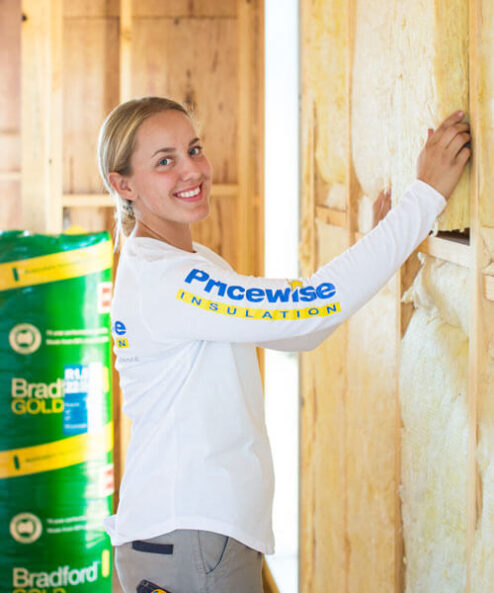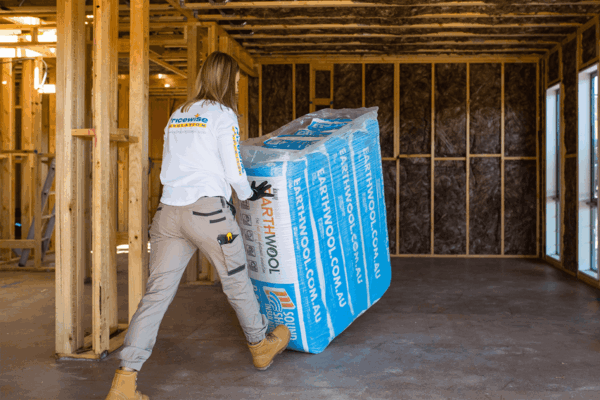Wall Insulation
Wall insulation plays a big part in creating a comfortable home. It’s not just an investment in long-term energy efficiency, but it also helps control your indoor comfort levels year-round, protects your home and contents from temperature extremes, and helps reduce energy bills.
Wall Insulation: Which R-Value Should I Choose?
An R-value indicates the ability of insulation to resist heat flow. The higher the R-value, the better the insulation at its main job of providing a thermal barrier. If you’re building a new home, the minimum R-values will be included in your energy report.
The National Construction Code (NCC) determines the minimum insulation for walls requirements for your climate zone. Another factor is how high your building site is above the Australian Height Datum (the mean sea level used for altitude measurement in Australia). Once you’ve met the minimum R-value for your area, choosing your internal wall insulation is also influenced by:
- Wall construction: Different wall types have different levels of natural insulating properties. If your home has lightweight or timber-framed walls, you may need to choose a higher R-value. If you have double-brick or concrete walls, a more moderate R-value wall insulation may be sufficient, depending on your climate.
- Intended use of the room: For frequently used rooms such as bedrooms and living areas, consider using higher R-value insulation in walls to better maintain a consistent temperature and maximise your energy savings.
Reasons to Install Insulation in Walls
By slowing down the transfer of heat, wall insulation helps keep warm air in during winter and hot air out during summer. It helps maintain a more stable indoor temperature throughout the day, making your living space feel consistently comfortable. Good wall insulation also contributes to the overall health of your home by preventing condensation and moisture-related issues such as mould.
Types of Wall Insulation Batts
There is a range of wall insulation batts that offer suitability for different projects.
- Knauf Earthwool: Easy to install and made using ECOSE® technology, meaning it contains no added formaldehyde. It’s a great option for homeowners seeking sustainable and allergy-friendly wall insulation batts. Earthwool performs well thermally and has solid acoustic properties, making it ideal for both internal and external walls where thermal comfort and low noise transfer are a priority.
- Bradford Gold Batts: Australian-made and designed to meet the needs of our varied climate. They offer excellent thermal performance in a range of R-values. They are also available in options with enhanced soundproofing qualities.
How to Insulate Existing Walls?
When considering how to insulate existing walls, keep in mind that older homes can be tricky. The good news is that there are retrofit solutions available. Techniques like blown-in insulation can be used to add thermal protection to walls without removing plaster or cladding.
For more extensive renovations, wall insulation batts can be fitted but will likely require professional installation as internal linings and cladding will need to be removed. Pricewise has a trusted network of retrofit specialists who can help you with your project.
Wall Insulation Batts Cost Per m2
It’s quite simple to calculate how many bags of insulation you will need for your project. The basic steps are as follows:
- Measure the total area to be insulated.
- Deduct any other areas not requiring insulation, such as windows and doors.
- Multiply the number by 0.9 to allow for the fact that the framing also takes up around 10% of the total area to be insulated.
- Divide this number by the number of m2 in a bag of insulation.
Why Choose Pricewise Insulation for Wall Insulation?
Pricewise insulation offers trusted brands, practical advice, competitive pricing, and fast delivery for insulating inside walls. Our expert team will help you choose the right wall insulation for your project, so you can get the most energy-efficient, comfortable, and healthy insulation results for your home.
Frequently Asked Questions About Wall Insulation
You can insulate walls during construction or renovation by fitting wall insulation batts, boards or wraps. To insulate existing walls, you will need to either use blow-in insulation or remove plasterboard.
If wall insulation is properly installed and kept dry, it can last up to 50 years or more.
Yes, wall insulation significantly improves indoor comfort by keeping warmth in during winter and out in summer. This thermal regulation reduces the need for the use of heating and cooling systems, meaning a more energy-efficient home and lower energy bills.





























